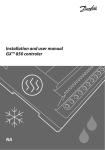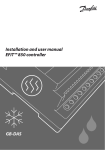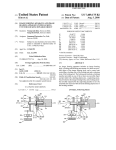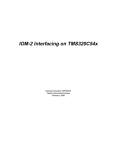Download GX 850 User Manual.indd
Transcript
Article: 088L8067 Version: 01.01 ˚F/˚C User Manual GX™ 850 controller 1 2 . . . . . . . . . . . . . . . . . . . . . . . . . . . . . . . . . . . . . . . . . . . . . . . . . . . . . . . . . . . . . . . . . . . . . . . . . . . . . . . . . . . . . . . . . . . . . . . . . . . . . . . . . . . . . . . . . . . . . . . . . . . . . . . . . . . . . . . . . . . . . . . . . . . . . . . . . . . . . . . . . . . . . . . . . . . . . . . . . . . . . . . . . . . . . . . . . . . . . . . . . . . . . . . . . . . . . . . . . . . . . . . . . . . . . . . . . . . . . . . . . . . . . . . . . . . . . . . . . . . . . . . . . . . . . . . . . . . . . . . . . . . . . . . . . . . . . . . . . . . . . . . . . . . . . . . . . . . . . . . . . . . . . . . . . . . . . . . . . . . . . . . . . . . . . . . . . . . . . . . . . . . . . . . . . . . . . . . . . . . . . . . . . . . . . . . . . . . . . . . . . . . . . . . . . . . . . . . . . . . . . . . . . . . . . . . . . . . . . . . . . . . . . . . . . . . . . . . . . . . . . . . . . . . . . . . . . . . . . . . . . . . . . . . . . . . . . . . . . . . 7 7 7 7 8 8 9 3 5 5 5 6 10 11 12 13 14 16 18 19 . . . . . . . . . . . . A: Menu system. . . . . . . . . . . . . . . . . B: How it works . . . . . . . . . . . . . . . . . Roof system . . . . . . . . . . . . . . Ground system . . . . . . . . . . . . Security and energy consumption C: PSU and feeder cable . . . . . . . . . . . Ground system . . . . . . . . . . . . Roof system . . . . . . . . . . . . . . . . . . . . . . . . . . . . . . . . . . . . . . . . . . . . . . . . . . . . . . . . . . . . . . . . . . . . . . . . . . . . . . . . . . . . . . . . . . . . . . . . . . . . . . . . . . . . . . . . . . . . . . . . . . . . . . . . . . . . . . . . . . . . . . . . . . . . . . . . . . . . . . . . . . . . . . . . . . . . . . . . . . . . . . . . . . . . . . . . . . . . . . . . . . . . . . . . . . . . . . . . . . . . . . . . . . . . . . . . . . . . . . . . . . . . . . . . . . . . . . . . . . . . . . 23 29 30 31 32 33 33 33 4: Appendix . . . . . . . . . . . . . . . . . . . . . . . . . . . . . . . . . . . . . . . . . . . . . : Technical data . . . . . . . . . . . . . . . . . . . . . . . . . . . . . . . . . . . . . . . . . . . . . . . . 21 Factory settings (Roof system) . . . . . . . . . . . . . . . . . . . . . . . . . . . . . . . . . . . . . . 22 Factory settings (Ground system) . . . . . . . . . . . . . . . . . . . . . . . . . . . . . . . . . . . . 22 3: Technical Specification System overview . . . . . . . . . . . . . . . . . General . . . . . . . . . . . . . . . . . . Installation of roof system . . . . . . Installation of ground system . . . . Installation of combi system . . . . . Setup of dual zone system . . . . . . Modification of system(s) . . . . . . . Replacing a malfunctioning sensor. 2:Setup Instructions . . . . . . . . . . . . . . . . . . . 1 mm² 1,5 mm² 2,5 mm² 4 mm² Number of sensors: Cable type Roof system 492’ (150 m) 820’ (250 m) 1312’ (400 m) 3281’ (1000 m) 5249’ (1600 m) 328’ (100 m) 1969’ (600 m) 1312’ (400 m) 1722’ (525 m) 1083’ (330 m) 656’ (200 m) 427’ (130 m) 31 984’ (300 m) 623’ (190 m) 360’ (110 m) 246’ (75 m) Max length (m) 2 pcs. PSU 24V, 24W in parallel 3 4 Max. length Max. length Max. length (m) (m) (m) 1 pcs. PSU 24V dc. 24W 1 2 2 pcs. PSU 24V, 1 pcs. PSU 24V 24W in parallel dc. 24W Number of sensors: 1 or 2 3 4 Cable type Max. length (m) Max. length (m) Max length (m) 985’ (300) 492’ (150 m) 262’ (80 m) 1 mm² 1476’ (450) 738’ (225 m) 394’ (120 m) 1,5 mm² 2460’ (750) 1247’ (380 m) 656’ (200 m) 2,5 mm² 3940’ (1200) 1969’ (600 m) 1017’ (310 m) 4 mm² Ground system Sensor cable extension . . . . . . . . . . 1: Operation Instructions System overview . . . . . . . . . . . . . . . . . . . . . . . General use . . . . . . . . . . . . . . . . . . . . . . . . . . Buttons . . . . . . . . . . . . . . . . . . . . . . . . Display. . . . . . . . . . . . . . . . . . . . . . . . . Menu system. . . . . . . . . . . . . . . . . . . . . Possible alarms during operation Clogged drain . . . . . . . . . . . . . . . . . . . . Missing sensor . . . . . . . . . . . . . . . . . . . . New added sensor . . . . . . . . . . . . . . . . . Sensor malfunction. . . . . . . . . . . . . . . . . Changing parameters and performance of systems. Roof system . . . . . . . . . . . . . . . . . . . . . Ground system . . . . . . . . . . . . . . . . . . . Appendix OperationCInstructions Table of Contents 30 The factory settings are average values providing a relatively high degree of security and moderate energy consumption. Low security – lower energy consumption Conversely, low energy consumption and a moderate level of security against ice and snow could be prioritized. In this case make the following adjustments of the operation parameters: • Decrease the standby temperature • Decrease the melting temperature • Increase the moisture level • Shorten the post-heat period This will give relatively low energy consumption, but the area may remain wet and icy in short periods. High security – higher energy consumption If a high degree of security against ice and snow is wanted, make the following adjustments of the operation parameters: • Increase the standby temperature • Increase the melting temperature • Decrease the moisture level (close to setting 5) • Prolong the post-heat period This will give a high degree of security in even dry areas. Security and energy consumption The ground system uses heated sensors which under normal circumstances will hold a temperature of 35°F (1.5°C). In connection with measuring the area temperature heating of the sensor is turned off for 90 minutes at a time. This is done in order to obtain a correct measurement of area temperature which is not influenced by sensor temperature. If a system only has one sensor this sensor is constantly heated for 90 minutes and then turned off for 90 minutes. This entails that measurement of temperature can be up to 3 hours delayed. With more than one sensor this performance is significantly improved. If system priority is low, heating might be paused at any time! System overview Post-heating If the reason for ending a heating period is a decrease of moisture to below the chosen level, the post-heating period will start. Post-heating ensures that no ice and snow is left on the ground. Consists of 2 x “Single ground systems (A and B)”. • 2 ground systems (dual system) Consists of 2 x “Single roof systems (A and B)”. • 2 roof systems (dual system) (combi system) Consists of 1 single roof system A and 1 single ground system B. • 1 ground system and 1 roof system To keep areas like parking areas, paths, garage entrances, steps, ramps, roadways and bridges free of ice and snow. (Ground systems A) • Single ground system To keep gutters, valley gutters and down pipes free of ice and snow, and to prevent ice dams from causing damage. It is also possible to use the roof system to reduce/remove the snow weight from a roof. (Roof system A) • Single roof system A A B A B A A B B A The GX™ 850 system is capable of keeping outdoor areas free of ice and snow. The GX™ 850 can handle up to 2 independent areas, in any of the following combinations: Operation Instructions OperationBInstructions Appendix 3 4 Ground system When more than 1 area is controlled by the GX™ 850 system, it is also possible to prioritize the areas. Prioritizing makes it possible to operate 2 areas, even if the required power for 2 areas is not present. For more information about the ice and snow melting function of the GX™ 850, please refer to: Appendix B: “How it works”. At least 1 roof sensor is needed for each roof area, but for complex roof constructions, 2 or more sensors are recommended. For more information please refer to the sensor manual. • Roof sensor (one or more) At least 1 ground sensor is needed for each ground area, but to get the best performance of a system, 2 or more sensors are recommended. For more information please refer to the sensor manual. • Ground sensor (one or more) The power supply delivers power to the controller unit and the connected sensors. • Power supply (one or more) A typical installation consists of: • Controller unit (only one) This is the device which, based on the measurements from the sensors, decides when to heat the connected area(s). The GX™ 850 is fully automatic and operated digitally by means of the intelligent sensors located in the heated terrain. Each sensor measures both temperature and moisture, and the system turns the heating elements on and off based on these readings. By combining moisture and temperature readings, the system is able to save around 75% energy compared to systems which only measure temperature readings. The digital sensors used for the GX™ 850 also provide the most exact readings when compared with corresponding analogue systems. The result is optimum functionality and low energy consumption. OperationBInstructions Appendix Operation Instructions Poat-heat time elapsed Standby Temperature >- Temperature < Standby temperature Standby 29 Melting ice and snow As long as the measured temperature is lower than the chosen melting temperature heating of the ground area will be on. When the measured temperature reaches the chosen melting temperature and the measured moisture level is below the chosen limit, the post-heating function will be activated. The post-heating function can be disabled. If moisture is detected on the ground area the system will continue to heat the area in order to maintain the melting temperature. It is, however, important to understand that even when the system is melting ice and snow it is not necessarily heating at all times. The heating will be turned on and off in accordance with the measured temperature in order to maintain a constant melting temperature. If the temperature rises more than 35°F (1.5°C) above the chosen melting temperature the system will automatically stop heating the area irrespective of the moisture on the area. Standby The system is on standby awaiting need for heating. If the measured temperature is below the chosen standby temperature the system will automatically heat the area in order to maintain the standby temperature. Melting (heating) will start when the two following conditions are fulfilled: • Measured moisture is higher than the chosen setpoint for moisture. • Measured temperature is lower than the chosen melting temperature Temperature and moisture are measured continuously by the sensors. Standby temperature (No heating) Mantaining standby The ground system is temperature Temperature < Melting temperature fully automated. It gathers and (Heating) Moisture > Moisture limit information on moisture Melting and temperature via digital (Heating) sensors continuously. The Moisture < Moisture limit sensors are placed on straPost-heating tegic spots on the ground (Heating) area (for further information on the sensor please refer to the sensor manual). By combining measurements of both moisture and temperature a reliable detection of the situation is achieved. Hence it is known whether heating is required to prevent ice and snow from covering the roof area. Temperature > Melting temperature + 1,5˚C 28 Post-heating If the reason for ending a heating period is a decrease of moisture to below the chosen level the post-heating period will start. Post-heating ensures that no ice and snow is left on the roof. Measuring temperature The heating function is suspended every third hour meaning that the heating cables are turned off. This is done in order to allow the sensors to measure the temperature, without being influenced by the heated cables. The temperature measurement may last up to 20 minutes. If the measured temperature is higher than the chosen melting temperature the heating period is ended; if not, heating of the roof area is resumed after the temperature measurement. Melting ice and snow The roof area is heated in periods of 3 hours. Within that period a decrease in moisture will stop the heating and activate post-heating. The post-heating function can be disabled. Standby The system is on standby and awaits heating of the roof area. Heating of the roof area will start when the following conditions are fulfilled: • Measured moisture is higher than the chosen setpoint for moisture. • Measured temperature is lower than the chosen melting temperature. Temperature and moisture are measured continuously by the sensors. The roof system is fully automated. Standby (No heating) It gathers information on moisture Temperature > Temperature < Melting temperature Melting temperature and temperature via digital sensors and Moisture > Moisture limit Measuring After 3 hours continuously. The sensors are placed Melting temperature 0-20 minutes (Heating) on strategic spots in gutters or down (No heating) pipes (for further information on Moisture < Moisture limit the sensor please refer to the sensor Post-heating Post-heating time elapsed manual). By combining measure(Heating) ments of both moisture and temperature a reliable detection of the situation is achieved. Hence it is known whether heating is required to prevent ice and snow from covering the roof area. General use B: How it works Roof system Next menu entry / next line / next letter Confirm / select Next Enter The GX™ 850 can simultaneously control up to 2 different systems. These 2 systems are referred to as System A and System B. The GX™ 850 gives the user the opportunity to view the current status of the systems. The status can be shown in 2 different ways. The following icons have a special meaning: This animated icon is shown, when the system is heating. If icon is blinking the system wants to heat, but is paused (system has low priority) This icon is shown, when the system has detected moisture, and the temperature is above the melting temperature. This icon is shown, when the system has detected snow or ice, and the temperature is below the melting temperature. Display Hold for 8 seconds: Master reset: Restore factory defaults AND delete installed systems. (In case of unsolvable problems due to a wrong choice of language, etc.) + Hold for 2 seconds: Return to home: Return to home of menu system Besides the normal function of the buttons, some special combinations are important to the user: Shows additional information / help (only active when lit) Info The functions of the 3 buttons are: Buttons The GX™ 850 is operated via 3 buttons and an alpha numeric display capable of displaying information in various languages. Operation Instructions OperationBInstructions Appendix 5 6 B:Ground >>Melting A:Roof >>Standby ˜ A:Roof ÚStandby View alarm menu 5s 5s ¯ˆı View sensor measurements View and set operating mode View sensor measurements View and set operating mode B:Ground ÚMelting S ys tem B S ys tem A O nly vis ible when S ys tem B is ins talled ! Select system B: Ground Select system A: Roof ˜ ¯ˆı A:Roof B:Ground . Please notice, that only a few of the menus for each system are shown! For a complete overview of the menu system, please refer to: Appendix A: “Menu system”. To the right is given an example of the main menu and the menus for System A and System B. No matter if the GX™ 850 controls one or two systems, the look and use of the menu system is always the same. This is obtained by making the entry to each system in the main menu. The possibilities and settings for each system are first accessible after the user has selected the desired system. and to get more information about the current status The menu system is navigated by the keys Menu system The user can always press irrespective of view selected. This view gives the user more detailed information about each system. Flipped view: The flipped view shows the status of one system at a time. The status of each system is shown for 5 seconds. View statistic Combined view (default): The combined view shows the status of both systems at the same time. System A is shown on the upper display line, and System B is shown on the lower display line. This view gives the user a quick overview of all the systems. A:Roof B:Ground Appendix A Operation Instructions Leave this menu: Press Û E2PROM version 0111 03 01.01 Text version 1011 03 01.01 Main FW version 0033 03 01.01 Boot FW version 0020 03 03.01 View connected sensors Relay operations 14680 Running time 2479h Operating time 3682h V iew s tatis tic s 04115C 0 Sensor2 Errors Leave this menu: Press Û 041153 0 Sensor1 Errors 27 26 sensors found! No ground If no new s ens ors are found (E xample s howing ground s ys tem). Replace sensor: Sensor2 03FC24 Cancel replace sensor? Add sensor: ID: 03ABC1 Add sensor: ID: 03DEF1 Cancel add sensor? Sensor added! Sensor replaced! Cancel replace sensor? Add sensor: ID: 03DEF1 Replace sensor: Sensor1 03FB2F Add sensor: ID: 03ABC1 If new s ens or(s) found and pas s ive s ens or (s) found. Only if any pas s ive(dis abled) s ens ors are working again ! If new s ens or(s) found, but no pas s ive s ens or (s) found. reactivated! 1 sensor(s) Checking system <------> - Acknowledge error and go to “Installer Site” in the menu system and select “Change System”. - Contact your local installer to get a replacement. Solution: Acknowledge error and go to “Installer Site” in the menu system and select “Change System”. Solution: Solution: Description: - Acknowledge error and go to “Installer Site” in the menu system and select “Change System”. - Contact your local service centre to get a replacement. Not all error prone sensors can be discovered using this feature! When something is wrong with the readings from connected sensors to the GX™ 850, an alarm is raised. Sensor malfunction When a new sensor is added, the GX™ 850 alerts the user and at the same time automatically switches to “Constant Off” mode. User interaction is needed in order to correct the error. Description: New sensor added When the connection to a sensor is lost, the GX™ 850 alerts the user. At the same time the GX™ 850 automatically switches the system to “Constant Off” mode, and user interaction with the GX™ 850 is needed. - Check gutter and down pipes for any obstacles preventing the melting water to flow away. - Check if sensors are covered with dirt. If the GX™ 850 controls more than 1 system, and prioritizing has been enabled, the time before clogged drain warning for the down-prioritized system, can be much longer. The time is only updated when the system actually is allowed to heat the area (e.g. the higher priority system is not heating) When clogged drain warning has been enabled, the system constantly has been detecting moisture for 14 days. Description: Missing sensor Solution: Description: Clogged drain Possible alarms during operation Change system C hange s ys tem Operation Instructions Appendix A 7 8 Installer menu Changing parameters and performance of systems System and sensor name It is possible to change the names of the system and connected sensors (see capital A: Installer menu. Clogged drain It is possible to enable and disable the “Clogged drain warning”. The factory setting is “Warning On”. Priority When using the GX™ 850 as a dual or combi system, it is possible to prioritize the systems. When the priority of 2 systems is equal, both systems can heat at the same time. If the priority of the 2 systems differs, and both systems want to heat, only the system with the highest priority is allowed to heat. The factory setting is 1 (highest priority) for all systems. Post-heat Once the sensor has detected that the roof/gutter is dry and free of ice and snow the system will keep heating for another hour (default). If you wish to increase/decrease this time see capital A: Installer menu. The factory setting is 1 hour (on a scale from 0 to 9 hours) Moisture level The “moisture level” decides when the system detects moisture. The factory setting is 50 (on a scale from 5 to 95). The lower the setting, the more sensitive the system is to moisture. Melting temperature Changing the melting temperature will affect when the system is activated in case of moisture and low temperatures. The factory setting is 35 °F (1.5°C). This means that the heating system will be activated if the temperature falls below 29 ° F (1.5°C) and moisture is detected. Roof system Only change the GX™ 850 parameters if you are aware of the effects of your actions. Reference: Appendix A: Installer menu Several parameters for each system can be changed during and after the installation. For a complete understanding of how these parameters affect the performance of the roof and ground system, please refer to Appendix B: “How it works”. Appendix A Operation Instructions Leave this menu: Press Û ÙC Select temp. indication Select temp. indication ÙC Select language English V iew s tatis tic s C hange s ys tem Set parameter Language Restore factory parameters View statistics Change system Leave this menu: Press Û Enter name: Sensor2 Rename sensor: Sensor2 Enter name: Soof Enter name: Sensor1 Enter name: Roof Rename system: Roof Rename sensor: Sensor1 Enter name: Rpof Select: Warning On Clogged drain Warning On Rename sensors in system Enter name: Roof Enter Priority 1 (High) Enter postheat 0 hours Set parameter Postheat = 1h Set parameter Priority = 1 Enter Melt. temp 1.0≥C Enter Stdb. temp -00.0≥C Set parameter Stdb. T =-3.0≥C Set parameter Melt. T= 4.0≥C Enter Moist. Lev 0_ Set parameter Moist. lev. = 50 Ins taller menu 25 24 View sensor parameters View parameter Postheat = 1H View parameter Priority = 1 Leave this menu: Press Û Sensor1 Moist. lev. = 10 Sensor2 Temp. = 26.2≥C Sensor surface Temp. = 27.3≥C View parameter Stdb. T =-3.0≥C View parameter Melt. T= 4.0≥C View parameter Postheat = 1H View parameter Priority = 1 Sensor1 Moist. lev. = 10 Sensor2 Temp. = 26.2≥C Sensor2 Moist. lev. = 11 Leave this menu: Press Û Leave this menu: Press Û View parameter Moist. lev. = 50 Sensor1 Temp. = 26.1≥C V iew s ens or meas urements (G round s ys tem) Leave this menu: Press Û V iew s ys tem parameters (G round s ys tem) View parameter Melt. T= 4.0≥C Sensor surface Temp. = 27.2≥C Sensor2 Moist. lev. = 11 View parameter Moist. lev. = 50 Sensor1 Temp. = 26.1≥C System and sensor name It is possible to change the names of the system and connected sensors. Clogged drain It is possible to enable and disable the “Clogged drain warning”. The factory setting is “Warning On”. Priority When using the GX™ 850 as a dual or combi system, it is possible to prioritize the systems. When the priority of 2 systems is equal, both systems can heat at the same time. If the priority of the 2 systems differs, and both systems want to heat, only the system with the highest priority is allowed to heat. The factory setting is 1 (highest priority) for all systems. Post-heat Once the sensor has detected that the roof/gutter is dry and free of ice and snow the system will keep heating for another hour (default). If you wish to increase/decrease this time see capital A: Installer menu. The factory setting is 1 hour (on a scale from 0 to 9 hours) Moisture level The “moisture level” decides when the system detects moisture. The factory setting is 50 (on a scale from 5 to 95). The lower the setting, the more sensitive the system is to moisture. Standby temperature (maintained ground temperature) The higher the standby temperature the faster the system will be able to melt ice and snow. On the other hand the higher the standby temperature the higher the running costs. So, determining the standby temperature is a trade-off between fast melting or low running costs. The factory setting is 27°F (-3 C°). Melting temperature Changing the melting temperature will affect when the system is activated in case of moisture and low temperatures. The factory setting is 39°F (4°C). This means that the heating system will be activated if the temperature falls below 4°C and moisture is detected. Ground system V iew s ys tem parameters (R oof s ys tem) View sensor measurements V iew s ens or meas urements (R oof s ys tem) Operation Instructions Appendix A 9 10 A typical ice and snow melting system consists of: • GX™ 850 • Only 1 GX™ 850 is allowed on the Devibus™ • Power supply • More power supplies can be connected in parallel (if needed) • Be aware of maximum number of sensors on each power supply (Refer to Technical Specification for power demand of sensors) • Ground and/or roof sensor(s) • Be aware of maximum number and cable length of sensors on each power supply (Refer to sensor manual for a more detailed description) Zone A is used for single system. When two zones are utilized, Zone A is always the priority. • Single roof system (1 system, 1-4 roof sensors) • Single ground system (1 system, 1-4 roof sensors) • 1 ground system and 1 roof system (combi system) (2 systems, 2-4 sensors total, minimum 1 sensor per system) • 2 roof systems (dual system) (2 systems, 2-4 sensors total, minimum 1 sensor per system) • 2 ground systems (dual system) (2 systems, 2-4 sensors total, minimum 1 sensor per system) The GX™ 850 can handle up to 2 independent areas, in any of the following combinations: System menu Main menu Appendix A: Menu system Setup Instructions System overview Appendix A Operation Setup Instructions Instructions ˜ A:Roof ÚStandby ¯ˆı View sensor measurements View and set operating mode View sensor measurements View and set operating mode B:Ground ÚMelting S ys tem B S ys tem A Leave this menu: Press Û Proceed ? ÛÛÛ Yes Installer site Ins taller menu V iew s ys tem parameters View system parameters Ω No V iew s ens or meas urements Leave this menu: Press Û Select mode: Constant ON Select mode: Constant OFF Select mode: Automatic Current mode: Automatic View sensor measurements View and set operating mode S ys tem menu(A / B) View alarm menu 5s 5s O nly vis ible when S ys tem B is ins talled ! Select system B: Ground Select system A: Roof ˜ ¯ˆı A:Roof B:Ground Return to main 23 On Automatic Clogged drain System mode • Automatic • Constant ON (manual timer) • Manually OFF On/off 0 to 9 hours 32°F (0°C) to 50°F (10°C) 5 to 95 (5 being the most sensitive to moisture) Range/Options 22 Factory settings 50 27°F (-3.0°C) 39°F (4.0°C) 1 hour On Automatic Function Moisture level Standby temperature Melting temperature Post-heat Clogged drain System mode • Automatic • Constant ON (manual timer) • Manually OFF On/off 0 to 9 hours 34°F (1°C) to 50°F (10°C) -4°F (-20°C) to 32°F (0°C) 5 to 95 (5 being the most sensitive to moisture) Range/Options Factory settings (Ground system) 35°F (1.5°C) 1 hour Post-heat 50 Moisture level Melting temperature Factory settings Function Factory settings (Roof system) Technical Specification System size: 1 system Checkingsystem <------> Selectlanguage: English Welcome to GX 850 III The rest of the installation is divided into the system configurations; roof, ground, combi or dual, as listed above. Select system configuration • Roof system (1 system) • Ground system (1 system) • Combi system (2 systems) • Dual system (2 systems) System is being checked… Select language Power on GX™ 850 General Accept setting with key: Change setting with key: 11 Please follow the general description and finally select the installation scenario according to the system type. The installation of the GX™ 850 is very easy, and the user is guided through the installation process. The installation process differs a little depending on which kind and the number of systems to be installed. Intial Setup Setup Instructions or wait… Config system: System A Checkingsystem <------> System A! Installed 1Roofsensor found. Accept? System type: Roof System A Scanning... Press 12 to end configuration. Press to end configuration. If for some reason you do not wish to configure the system now you can press skip configuration of system . Please refer to “Changing parameters and performance of systems” in “User Manual” for description of the configurable parameters. Press to configure System A. (Naming sensors and changing factory settings) System is being checked… Press when all sensors are found… System A is installed… Wait until correct number of sensors for System A is found. Select system type: Roof System is being scanned to find type of connected sensors… Press If sensors for System A are not connected - do it now! to D850 DP-10 Type: • GX™ 850 * For further information on the sensors please refer to the sensor manual. (Depth x Height x Width) 2.09” (53 mm) x 3.39” (86 mm) x 4.13” (105 mm) 0.6” (15 mm) x 0.93” (23.5 mm) x 8.5” (216 mm) D = 3.4” (23.5 mm); height = 2.9” (74 mm) D = 3.66” (93 mm); height = 3.86” (98 mm) * 2 x 16-character illuminated display Alarm light (red) Lit info key (yellow) * * Measurements: • GX™ 850 • Roof sensor(s) • Ground sensor(s) • Tube ground sensor(s) Devibus™ connected moisture sensor(s) Indication: 14°F ( -10°C) to 104°F ( +40°C) -58°F (-50°C) to 158°F (+70°C) -22°F (-30°C to 158°F (+70°C) Ambient temperature: • GX™ 850 • Roof sensor(s) • Ground sensor(s) * * Sensor type: NEMA1 NEMA6 NEMA6 230V ~ 2A 230V ~ 15A 230V ~ 15A 1A (power factor 0.3) * * Nema rating: • GX™ 850 • Roof sensor(s) • Ground sensor(s) Relay load capability: • Resistive load Alarm realy • Resistive load System A relay • Resistive load System B relay • Inductive load each realy Max. 3 W Max. 8W (each) Max. 13W (each) Power consumption: • GX™ 850 • Roof sensor(s) • Ground sensor(s) Connectsensors: System A Voltage: • GX™ 850 • Power supply It is optional if the sensors are connected to the GX™ 850 before power on or during the installation. The system uses the output System A. 18-26 VDC 180-250 VAC, 50/60 Hz Technical data Technical Specification Setup of roof system The installation of a GX™ 850 with 1 roof system has been selected. Technical Specification Setup Instructions 21 20 If the user selected a new sensor to add, the sensor is added. Press when the correct new sensor to add is found or “Cancel add sensor?” is selected. Press to loop through the found new sensors or to cancel add sensor. Add an extra sensor: From the installer menu select Change system. The system is searching for connected sensors. Setup Instructions Sensor added! Cancel add sensor? Add sensor: ID: 03ABC1 Checkingsystem <------> or wait… Press to end configuration. system now you can press the system. to skip configuration of Please refer to “Changing parameters and performance of systems” in “User Manual” for description of the configurable parameters. If for some reason you do not wish to configure the Press to configure System A. (Naming sensors and changing factory settings) System is being checked… Press when all sensors are found… System A is installed… Wait until correct number of sensors for System A is found. Select system type: Ground System is being scanned to find type of connected sensors… Press If sensors for System A are not connected - do it now! The system uses the output System A. Press to end configuration. Config system: System A Checkingsystem <------> System A! Installed 3Groundsensor found. Accept? System type: Ground System A Scanning... Connectsensors: System A It is optional if the sensors are connected to the GX™ 850 before power on or during the installation. The installation of a GX™ 850 with 1 ground system has been selected. Setup of ground system Setup Instructions 13 14 System type: Ground Select system type: Ground (if ground system is preferred as System B) Connectsensors: System B System B Scanning... or wait… System is being scanned to find type of connected sensors… Press If sensors for System B are not connected - do it now! System A! Installed 1Roofsensor found. Accept? Wait until correct number of sensors for System A is found. Press when all sensors are found… System A is installed… System type: Roof Select system type: Roof (if roof system is preferred as System A) Connectsensors: System A System A Scanning... or wait… System is being scanned to find type of connected sensors… Press If sensors for System A are not connected - do it now! It is freely selectable if System A should be the roof or ground system. However it is preferable that System A is the roof system, since System A is shown on the upper line of the display. Please refer to the description of the Display and Combined view in the user manual. The first installed system (System A) is using the output System A. The second installed system (System B) is using the output System B. It is optional if the sensors are connected to the GX™ 850 before power on or during the installation. If the user selected a new sensor to add, the replacing of the sensors is performed. Press when the correct new sensor to add is found or “Cancel replace sensor?” is selected. Press to loop through the found new sensors or to cancel replace sensor. If the user selected a passive sensor to replace, the user should now select the new sensor. Press when the correct passive sensor or “Cancel replace sensor?” is selected. Press to loop through the found passive sensors or to cancel replace sensor. The user selects the passive sensor, which should be replaced with a new one. From the installer menu select Change system. The system is searching for connected sensors. Replace a malfunctioning sensor: Setup of combination system The installation of a GX™ 850 with 1 roof system and 1 ground system has been selected. Setup Instructions Setup Instructions Sensorreplaced! Cancel replace sensor? Add sensor: ID: 03DEF1 Add sensor: ID: 03ABC1 Cancel replace sensor? Replace sensor: Sensor2 03FC24 Replace sensor: Sensor1 03FB2F Checkingsystem <------> 19 to activate Change system. 18 If no new sensors are found, it is reported to the user. Message is shown for 3 seconds. If any passive sensors are found, they are reactivated. Message is shown for 3 seconds. The system is searching for connected sensors. Press From the installer menu select Change system. Reactivate passive sensors: The given example is for a ground system. No ground sensors found! 1 sensor(s) reactivated! Checking system <------> Change system It is not possible to delete a passive sensor in a system. Passive sensors will remain in the systems until they are replaced with new sensors. The only way to delete a passive sensor (other than replacing it), is to make a Master Reset and reinstall the GX™ 850 (please refer to chapter: General use). If the malfunctioning is caused by an error prone sensor, the error can be corrected by replacing the error prone sensor with a new sensor. If the malfunctioning is caused by problems with the wiring, the failure can be fixed, and the sensor can be reactivated. When the GX™ 850 cannot communicate with a sensor, the GX™ 850 reports the error: “Errors detected!”. The GX™ 850 does not rely on malfunctioning sensors, and therefore the GX™ 850 makes the sensor passive. The passive sensor is no longer used for ice and snow detection - not even after a power cycle. to select system to configure. Press to end configuration. Please refer to “Changing parameters and performance of systems” in “User Manual” for description of the configurable parameters. to configure selected system. Press (Naming sensors, changing factory settings and setting priorities) Press System is being checked… when all sensors for System B are found… Press System B is installed… Wait until correct number of sensors for System B is found. Modification of system(s) It is possible to modify the installed systems on the GX™ 850. The following modifications are possible: • Reactivate passive sensors • Replace a malfunctioning sensor • Add an extra sensor Setup Instructions Setup Instructions Press to end Configuration. Config system: System B Config system: SystemA Checking system <------> System B Installed! 3Groundsensors found. Accept? 15 or wait… System B Scanning... System type: Ground System is being scanned to find type of connected sensors… Select system type 16 or wait… Connectsensors: SystemB Press Connect sensors for System B. System A Installed! 1Groundsensor found. Accept? Wait until correct number of sensors for System A is found. Press when all sensors for System A are found… System A is installed… System type: Ground System A Scanning... Connectsensors: System A Select system type System is being scanned to find type of connected sensors… Press If sensors for System A are not connected - do it now! The first installed system (System A) is using the output System A. The second installed system (System B) is using the output System B. It is mandatory that no sensors or only sensors for System A are connected to the the GX™ 850 before power up. Sensors for System B must be connected to the GX™ 850 during the installation steps. Connection of the sensors during installation can either be done using a switch on the DIN-rail or just connect sensor bus of System B to the already connected sensor bus of System A. to select system to configure. Press to end configuration. Please refer to “Changing parameters and performance of systems” in “User Manual” for description of the configurable parameters. to configure selected system. Press (Naming sensors, changing factory settings and setting priorities) Press System is being checked… when all sensors for System B are found… Press System B is installed… Wait until correct number of sensors for System B is found. Setup of dual zone system The installation of a GX™ 850 with 2 roof systems or 2 ground systems has been selected. Setup Instructions Setup Instructions Press to end Configuration. Config system: System B Config system: SystemA Checking system <------> System B Installed! 1Groundsensor found. Accept? 17
































